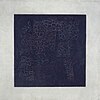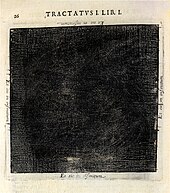The black square
| Black square |
|---|
| Kazimir Malevich |

|
| Quadrangle , 1915 |
| Oil on canvas, 79.5 cm × 79.5 cm |
| Tretyakov Gallery, Moscow |
|
|

|
| Pictorial masses in two dimensions in a state of calm , 1915 |
| Oil on canvas, approx. 30–35 cm × approx. 30–35 cm |
| lost |
|
|

|
| Black Square , 1924 |
| Oil on canvas, 106.0 cm × 106.0 cm |
| Russian Museum, St. Petersburg |
|
|

|
| Black Square , May 1929 |
| Oil on canvas, 80.0 cm × 80.0 cm |
| Tretyakov Gallery, Moscow |
|
|

|
| Black square , 1930 or 1932 |
| Oil on canvas, approx. 53.5 cm × 53.4 cm |
| Hermitage, St. Petersburg |
The Black Square is the title of several paintings by Kazimir Malevich , the first of which was first exhibited in 1915 at the 0.10 exhibition. It is one of the icons of the painting of the 20th century. The picture, painted with oil on canvas, is 79.5 x 79.5 centimeters and is located in the Tretyakov Gallery in Moscow . Another square shown in the exhibition 0.10, which was probably also black, has been missing since 1915. Malevich painted another painting with the motif of the black square in 1924. It is exhibited in the Russian Museum in Saint Petersburg and is 106 × 106 cm in size. In the Tretyakov Gallery in Moscow there is also a version from 1929 measuring 80.0 × 80.0 cm. Another version is in the Hermitage , Saint Petersburg. It is approximately 53.5 cm × 53.4 cm and is dated to 1930 or 1932. It cannot be ruled out that there are other versions of this motif. There are also several drawings and lithographs on the subject.
Motif
In the summer of 1913 the composition of the opera Sieg über die Sonne was composed in Uusikirkko (Poljany) . The futuristic opera premiered on December 3, 1913 in the Lunapark Theater in St. Petersburg. Velimir Khlebnikov wrote the prologue, Alexej Krutschonych the libretto, the music was by Mikhail Matjuschin and the set and costumes by Malevich. He drew the first black square on a stage curtain . This is also the reason why Malevich shifted the birth of Suprematism to 1913 and did not refer to the suprematist images of 1915 in the true sense of the word.
The painting The Black Square was shown for the first time on December 7, 1915 at the last futuristic exhibition 0.10 in the Dobytčina Gallery in Petrograd (Saint Petersburg). It was attached to the highest point in a corner of the room with the picture surface slightly sloping downwards, surrounded by other pictures by Malevich. The Black Square took it, in the Lord angle , the position, which in a traditional Russian house of a religious icon is reserved.
The area painted in black is surrounded by a border painted in white. Malevich called it “square” in the exhibition catalog because it does not correspond to an exact square and the sides are not parallel to each other.
“When I made the desperate attempt in 1913 to free art from the weight of things, I exhibited a painting that was nothing more than a black square on a white field [...] It was not an empty square that I exhibited, but rather the feeling of non-objectivity. "
The translucent
The English doctor and natural philosopher Robert Fludd has in the first volume of Utriusque cosmi maioris scilicet et minoris Metaphysica, physica atque technica Historia ( metaphysics and natural and art history of both worlds, namely the macro and the microcosm ), a history of the macrocosm , a story of creation visualized, which begins with the archetype of the hyle , the equivalent of nothing , as a black square. In Malevich's square paintings, the black of the surface varies from version to version. In the illustration on the right, structures of intersecting “threads through which tiny horizontal rectangles of light shine” can be seen on the four edges. This “fabric structure” is superimposed on the inside of the square by a further application of black, which only allows a view of the thread structure in its outer area.
The fabric-like lower membrane thus places the black of nothingness over the light that shines through the membrane. The clouds of chaos, which are formed with the additional paint application above, lie above. Circular and spiral lines have been scratched into them, which since Leon Battista Alberti have been considered the lines of natura naturans , the possibility of movement to indicate light.
Kazimir Malevich proceeded in a similar way. He had almost finished a painting, but in the same year, before it had dried, he decided to paint over the picture in a homogeneous black, a process that subsequently forms craquelure . The fine cracks that were soon to be visible in the black had been created by the artist from the start. X-rays show "how the brightness of what has already been painted breaks through the black from below."
Influence on contemporary and later artists
On the influence that the Black Square had on other artists, see Malevich's Influence on Contemporary and Later Artists .
See also
literature
- Jeannot Simmen: Kasimir Malewitsch - the black square . Fischer Verlag, Frankfurt am Main 1998, ISBN 3-596-12419-0
Web links
- Petra Kipphoff: Black fabric . In: Die Zeit of March 29, 2007, No. 14.
- Maria Becker: King's Boy - Kasimir Malewitsch's "Black Square"
Individual evidence
- ↑ This title is mentioned in the catalog for exhibition 0.10 .
- ↑ The painting is only known from a black and white photograph, it could also have been painted in a dark shade. The title comes from the exhibition catalog for October 0.
- ↑ Andréi Nakov: Kazimir Malewicz. Catalog raisonné. Biro, Paris 2002.
- ^ Noemi Smolik: Last futuristic exhibition 0.10, Petrograd 1915 - the end of development . In: Bernd Klüser, Katharina Hegewisch (Hrsg.): The art of the exhibition. A documentation of thirty exemplary art exhibitions of this century , p. 64
- ↑ Horst Bredekamp : Beuys as a companion of form . In: Ulrich Müller: Joseph Beuys. Parallel processes. Archaeologist in an artistic practice . Hirmer, Munich 2012, ISBN 978-3-7774-6011-6 , p. 28
- ↑ Horst Bredekamp: Beuys as a companion of form . In: Ulrich Müller: Joseph Beuys. Parallel processes. Archaeologist in an artistic practice . Hirmer, Munich 2012, p. 29
- ↑ Horst Bredekamp: Beuys as a companion of form . In: Ulrich Müller: Joseph Beuys. Parallel processes. Archaeologist in an artistic practice , Munich 2012, p. 30


